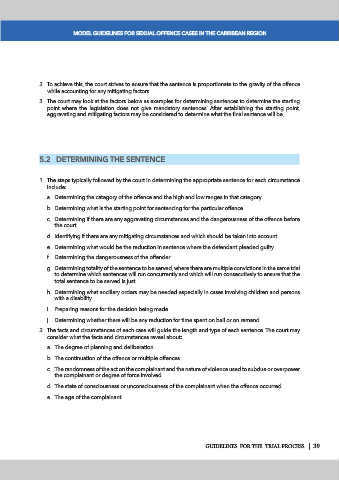Page 639 - Magistrates Conference 2019
P. 639
MODEL GUIDELINES FOR SEXUAL OFFENCE CASES IN THE CARIBBEAN REGION
2. To achieve this, the court strives to ensure that the sentence is proportionate to the gravity of the offence
while accounting for any mitigating factors.
3. The court may look at the factors below as examples for determining sentences to determine the starting
point where the legislation does not give mandatory sentences. After establishing the starting point,
aggravating and mitigating factors may be considered to determine what the final sentence will be.
5.2 DETERMINING THE SENTENCE
1. The steps typically followed by the court in determining the appropriate sentence for each circumstance
include:
a. Determining the category of the offence and the high and low ranges in that category.
b. Determining what is the starting point for sentencing for the particular offence.
c. Determining if there are any aggravating circumstances and the dangerousness of the offence before
the court.
d. Identifying if there are any mitigating circumstances and which should be taken into account.
e. Determining what would be the reduction in sentence where the defendant pleaded guilty.
f. Determining the dangerousness of the offender.
g. Determining totality of the sentence to be served, where there are multiple convictions in the same trial
to determine which sentences will run concurrently and which will run consecutively to ensure that the
total sentence to be served is just.
h. Determining what ancillary orders may be needed especially in cases involving children and persons
with a disability.
i. Preparing reasons for the decision being made.
j. Determining whether there will be any reduction for time spent on bail or on remand.
2. The facts and circumstances of each case will guide the length and type of each sentence. The court may
consider what the facts and circumstances reveal about:
a. The degree of planning and deliberation.
b. The continuation of the offence or multiple offences.
c. The randomness of the act on the complainant and the nature of violence used to subdue or overpower
the complainant or degree of force involved.
d. The state of consciousness or unconsciousness of the complainant when the offence occurred.
e. The age of the complainant.
GUIDELINES FOR THE TRIAL PROCESS | 39

